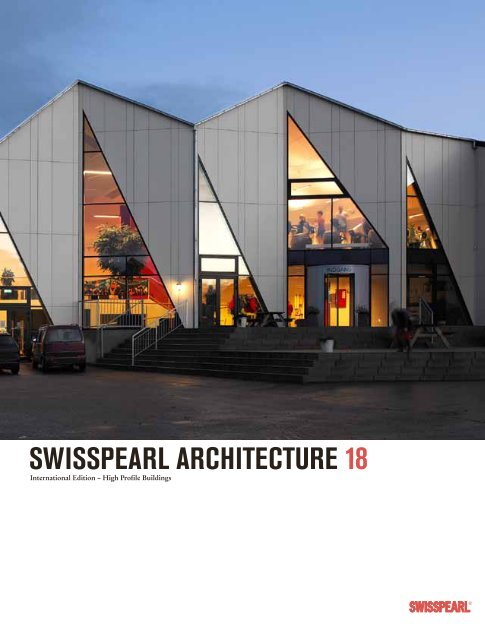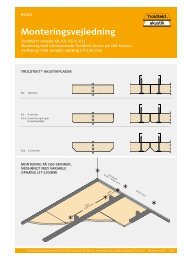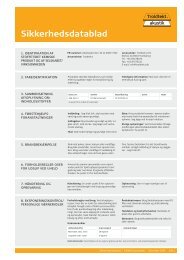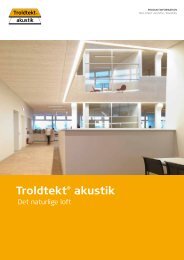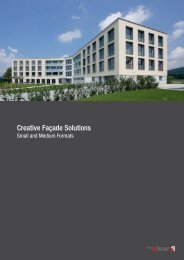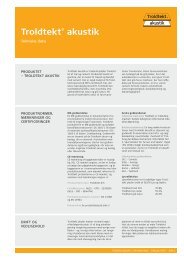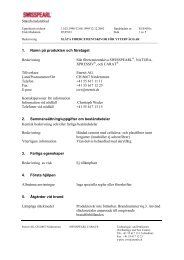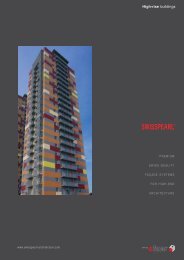SWISSPEARL ARCHITECTURE 18
SWISSPEARL ARCHITECTURE 18
SWISSPEARL ARCHITECTURE 18
Create successful ePaper yourself
Turn your PDF publications into a flip-book with our unique Google optimized e-Paper software.
Materiality and Expression in Public ArchitecturePOSTMODERN LEGACYArchaeologists and historians tend to use the term ‘publicbuilding’ interchangeably with ‘monument’, referringin either case to large-scale structures such as temples,plazas or platform mounds that were built for public purposesand whose construction usually involved a communityeffort. However, changing perceptions of the publicas such have led to a narrower understanding, denotingbuildings that are not only open and accessible to the public,but also owned and operated by the political bodiesthat represent them. Despite this disambiguation, theterm remains vague, as both the public themselves andwhat constitutes a use by them are left largely undefined.Furthermore, popular public spaces such as train stations,urban plazas and shopping centres are, in fact, privatelyowned, whereas classic examples of public architecturesuch as state schools and universities or city parks andplaygrounds increasingly control and restrict access to allbut a select few.Indeed, given the inextricable mingling of public andprivate aspects, the very notion of ‘public architecture’ hasbecome somewhat of an anachronism. Yet, architecturalcommentators seem largely unperturbed by this, continuallyapplying the term to a number of established build -ing types regardless of their de facto ownership and usage.2Ultimately, our concept of public architecture is a remnantof the post-enlightenment era when the rising middleclasses expressed their civic pride by erecting imposingedifices for the greater good of the general public. Theemergence of civil societies in the 19 th century coincidedwith the period of historicist architecture, and the Neo-Renaissance style chosen for schools, hospitals, museumsor courthouses alludes to the humanist values that oughtto be expressed through such buildings. Precious façadematerials such as limestone or marble constituted a deliberatebreak with the timber and brick of local domesticvernaculars and highlighted the significance of these publicbuildings – particularly in regions where natural buildingstone was not readily available and had to be importedat great expense.To historicist architects such as Gottfried Semper, andin his succession, Otto Wagner, the façade cladding symbolisedthe inner truth of a building, thus elevating it to awork of art. This idea was lost on the modernists of theearly 20 th century who saw any sheathing of the façade asa betrayal of a building’s structural truth and integrity andfirmly rejected the idea of materials expressing anythingother than themselves and the manner of their assembly.It was not until mid-century that the modernist distrustChrist the King JesuitCollege PreparatorySchool in Chicago byJohn Ronan Architects.
Bus Station in Velenje,Slovenia, by GužičTrplan Arhitekti.Kannisto School inVantaa, Finland,by Linja Architects.of the surface and the fetish of transparency and dematerialisationcame under scrutiny, and the decisive counterreactionagainst the inexpressiveness of the prevailing architecturearose from within the very heart of the modernmovement.Sigfried Giedion’s call for a ‘New Monumentality’ in1944 reflected the growing dissatisfaction with the functionalistdoctrine and led to a revaluation of the civic andcultural role of the city, which in turn spawned an increasedinterest in the expression and representation ofpublic buildings, not least through their materiality.Council architects in Britain, which initiated an unparalleledpublic building programme after the War, relied almostexclusively on sculptural béton brut in the traditionof Le Corbusier’s Unité to advertise the modernity of theirinstitutions. Elsewhere, the United States government inthe mid-1950s embarked on an ambitious embassy buildingprogramme which inspired architects to introduce awide selection of thus far neglected façade materials intothe modernist vocabulary, both to express the symbolicimportance of their buildings and to blend them in withthe local surroundings. Walter Gropius, for instance,chose a variety of Greek marbles for his Athens embassy,while Eero Saarinen used locally produced granite chipterrazzo in Oslo and a Portland stone cladding in London,respectively.By the last quarter of the century, modernism as a homogenous‘International Style’ had largely run its course,giving way to a plurality of architectural expressions in itsstead. The reappraisal of the façade as a carrier of meaningin a socio-urban context and the variety of claddingmaterials employed to this effect are lasting legacies ofthe postmodern period, reverberating in the predilectionfor experiments in façade design which is a hallmark oftoday’s architectural output.This applies even in cases that otherwise lack any obviouspostmodernist affiliation. John Ronan’s work inChicago, for instance, combines a Miesian design approachwith a façade language reflecting the specific aspiration– or ‘inner truth’ – of the respective institution, beit the youthfulness of his Gary Comer Youth Center(<strong>SWISSPEARL</strong> <strong>ARCHITECTURE</strong> 4) or the corporate approachof his Jesuit College Prep School (<strong>SWISSPEARL</strong><strong>ARCHITECTURE</strong> 12). Ronan is among a growing numberof architects who make full use of the versatility of Swisspearlpanels in order to create a fresh image for publicbuilding types, from educational facilities to sports arenasand community centres. Some architects choose a ratherliteral approach to representation, as is the case with S/L/A/M Collaborative’s Gilmartin School in Connecticut(<strong>SWISSPEARL</strong> <strong>ARCHITECTURE</strong> 14) or FSS Sports Centrenear Belgrade (page 22ff.), both of which feature a panelarrangement in the country’s national colours. More often,however, they opt for a more restrained façade design.Examples such as Arch Design’s school in Ljubljana(page 12–13) or the Garage Groupe Architect’s MedicalFaculty in Serbia (page 40–41) recall the timeless crispnessof stone-clad buildings while offering eco-credentialsworthy of a 21 st century public building. Patrick Zamariàn<strong>SWISSPEARL</strong> <strong>18</strong> 3
It seems only right that nowadays when children are being taught about the importance of climatechange, a newly built school should be sustainable and environmentally friendly.Mårtensbro School, Espoo, FinlandTEACHING ECOLOGICAL THINKING<strong>SWISSPEARL</strong> <strong>18</strong> 5
Playa Architects won the design competition for theMårtensbro School in Espoo, southern Finland. Theirplan responds to the topography of the site: by embeddingthe building in the slope, they created a single-storeyday care wing with a triple-storey structure on the northernside. Submerged in the landscape, the sports hall onthe northeast corner anchors the building on the site. Thecomplex accommodates a day care centre and a school for550 pupils and 70 staff members. Two distinct wings ofclassrooms are formed by the fork-shaped plan, while thespace at the junction of the two wings holds an open,light-filled entrance lobby as well as the dining hall, stage,library and a wide staircase that connects to the rear entranceand parking. The open exterior space created bythe Y-shaped plan provides a place where the children canplay outdoors sheltered from the bitter northerly winds.The façades that enclose this space feature floor-to-eaveslaminated timber fins that act as sunshades and emphasisethe curved line of the eaves. Projecting fins create a livelyrhythm and a play of shadow along the façade. Betweenthe fins, the vertical surface planes are alternatively transparent:glazed or clad in light-grey Swisspearl panels.Mårtensbro School was a pilot project for buildingenergy-efficient schools in Espoo. Geothermal energy isused for heating and cooling, while solar energy is harvestedby solar panels and thermal collectors. The buildingis being used to test the efficiency of a forced-air system,and during construction an array of wireless RFIDsensors was embedded into the structure to provide realtimedata on the building. The rooms have been equippedwith occupancy sensors in order to minimise unnecessaryenergy consumption when the spaces are not being used.Thanks to these measures, the school has achieved an‘A’ rating on the Energy Performance Certificate, with asimu lated energy consumption of only 91 KWh per squaremetre annually.In addition to the strong ecological aspect, the materialityof the complex is a further significant aspect N of the??design. The texture and tactility of the façades is articulatedby hand-made eggshell-white bricks, which seemwoven together in a relief pattern that wraps its wayaround the rear façades. Carved from the primary volume,the loading area is demarcated by custom-made emeraldgreen Swisspearl panels that clad the walls and ceilingof the cut-out area. The architects selected Swisspearlfor a variety of reasons: it is a high-quality, durable material,they were able to choose a custom colour and panelsize and they also liked the elegant hidden attachment system.The low flammability of the material was also essentialto comply with the strict local building regulations.The building is a tribute to the fact that it is indeed possibleto marry high architectural quality with high ecologicalgoals. Anna Roos6
Tall, slender fins actas sunshades, createa rhythm and givethe elevation depth.<strong>SWISSPEARL</strong> <strong>18</strong> 7
8Custom-colouredSwiss pearl panelsarticulate the deliveryspace cut out of themasonry form.
<strong>SWISSPEARL</strong> <strong>18</strong> 11
Natur / SteinplatIsolation 0,035Backstein 0,035H123453Fertigbeton 0,03567cement composite panel 8 mmavitylationrdhade panelsljanale: 1:?o: 1:?Vertical section 1:201 Swisspearl ® cement composite panel 8 mm2 ventilation cavity3 thermal insulation4 concrete5 gypsum board6 aluminium shade panels7 bracketLjubljanaScale: 1:1000LjubljanaScale: 1:1000Beton 0,035SituationN ?N ?First floor 1:1000Ground floorPläne<strong>SWISSPEARL</strong> <strong>18</strong> 13
Primary School, Valmiera, LatviaBridge to KnowledgeThis primary school is composed of different functionalunits, each individually expressed. Architects Ozola & Bulacombined a variety of finishes and colours to create ainspirational learning environment.Located in the Latvian town of Valmiera, this awardwinningprimary school houses nearly 500 children betweenthe ages of 7 and 13. Complementing an existingsecondary school on the same site, the new facility adoptsthe latter’s angularity and rugged contours, contrastingsharply with a number of circular landscape features, suchas the lowered front entry area, an amphitheatre andseveral recreation areas to the rear.The architects devised an E-shaped plan featuring anelongated hall defined by a sequence of three staggeredclassroom wings on one side and additional facilities suchas administrative offices, an auditorium and a gym on theother. Each of these functional units is articulated as a separatevolume, adding rhythm and plasticity to the building.The school is envisaged as a pedagogic tool with designmeasures geared towards enriching the pupils’ spatial experienceand arousing their intellectual curiosity. A wideconcrete footbridge accentuates the main entrance, symbolisingthe students’ transition from the outer world intothe realm of knowledge. The hall features two open staircasesthat visually link it to the two upper floors, whilefull-height glazing between the individual units allows aview of the picturesque surroundings. Striking abstractcolour patterns, applied to both walls and floors, createadditional visual interest in the interior.The façade design reflects this approach by combininga variety of finishes, which in turn reflect the historicaland architectural context of the new school as well as14
ValmieraMst: 1:?“THE WHITE <strong>SWISSPEARL</strong> CEMENT COMPOSITE PANELS GIVELIGHTNESS, MODERNITY AND ELEGANCE TO THE BUILDING.”OZOLA & BULAits academic aspirations. Both the yellow clinker bricktiles and the red and brown plastering of certain wallpartitions refer to the existing secondary school building.In contrast, the white Swisspearl panelling that covers theprotruding school wings adds, according to the designers,a sense of “lightness, modernity and elegance” to thebuilding. Patrick Zamariàn<strong>SWISSPEARL</strong> <strong>18</strong> 15
Achsen 0,09Hinterlüftungsspalt von min. 2,5 cm78 9 10KibaekScale: 1:1000MassivhHolzwerNatur / S123454 5 4 6KibaekScale: 1:1000Isolation 0,035Backstein 0,046Vertical section 1:20 First floor 1:10001 Swisspearl® 1 Swisspearl cement ® cement composite composite panel panel 8 mm 8 mm2 ventilation 2 ventilation cavity, cavity, wooden wooden batten batten3 moisture 3 moisture barrier, barrier, cement cement chip board chipboard4 thermal 4 thermal insulation insulation5 vapour 5 vapour barrier barrier6 timber 6 timber fibre board fibre board7 waterproofing7 waterproofing8 plywood, 8 plywood, moisture moisture-resistantresistant9 wooden 9 wooden batten batten10 ventilation 10 ventilation cavity cavityFertigbeton 0,035Beton 0,035Ground floor20
“IN ORDER TO MINIMISE OPERATION AND MAINTENANCE COSTS, THE BUILDINGIS COVERED WITH YELLOWISH SAND-COLOURED <strong>SWISSPEARL</strong> PANELS.”PRO ARKITEKTER/THORUP GRUPPENLocation Velhustedvej 12, Kibæk, DenmarkClient Kibæk Krydsfelt, KibækArchitects Pro Arkitekter, Højbjerg, Denmark; Per Mikkelsen, incooperation with Thorup Gruppen, Tarm, Denmark; Paul LangeBuilding period 2010–2011Façade construction René Lauritsen, Sønder Omme, DenmarkFaçade material <strong>SWISSPEARL</strong> ® CARAT, Amber 7082<strong>SWISSPEARL</strong> <strong>18</strong> 21
The key element of this layout is a ring road which encircles the Sports Centre and allows car access to all its facilitiesand football pitches. The various functions are distributed into separate building units; a universal red-and-whitecolour scheme unites the different parts of the complex.FSS Sports Centre, Stara Pazova, SerbiaSPORTING THE TEAM COLOURS<strong>SWISSPEARL</strong> <strong>18</strong> 23
Stara Pazovavertical Stara Pazova sectionvertical Mst: 1:20sectionMst: 1:2016 3 816 3 8va1 Swisspearl® cement composite panel 8 mm2 ventilation cavity3 thermal insulation4 concrete1 Swisspearl® cement composite panel 8 mm5 ceramic flooring tile2 ventilation cavity 1 Swisspearl6 waterproofing® cement composite panel 8 mm3 thermal insulation 2 ventilation cavity7 cement screed4 concrete3 thermal insulation8 steel tube5 ceramic flooring tile 4 concrete6 waterproofing5 ceramic flooring tile7 cement screed6 waterproofing8 steel tube7 cement screed8 steel tubeN ?123142345 65 67 3 4Vertical section 1:20247 3 4
StarapazovaMst: 1:2000Located in the city of Stara Pazova, the FSS Sports Centreserves as a state-of-the-art training centre for the Serbiannational football team. The in-house design division of theInstitute of Transportation (CIP) was in charge of theplanning process; unsurprisingly, vehicular access andpedestrian circulation were the key aspects of the spatialorganisation.The building complex is composed of separate functionalunits and encircled by a ring road that provides accessto the various football pitches and training grounds.The central part of the main building houses the receptionarea and serves as the hub of the facility – flanked on oneside by the administrative block and on the other by anangled two-part accommodation block. To the rear, themain building connects with a single-story sport serviceunit, which comprises the locker rooms as well as variousrecreation and rehabilitation facilities and also doubles asa hallway leading to the multi-purpose sports hall.The designers opted for a red and white scheme inspiredby the country’s national colours. The exteriorwalls are clad in light-grey Swisspearl panels, except forsegments of the main façade, which are rendered in adarker shade and feature decorative roof parapets thatpartially conceal the building’s pitched roof. In contrast tothe uniform white envelope, elements such as the portico,railings and canopies, as well as a series of decorative finsin the courtyard area and the stands of the central pitch,are accentuated by their bright red colour. Patrick ZamariànGround floor 1:2000Location Volarsko polje, Stara Pazova, SerbiaClient Football Association of Serbia (FSS), Belgrade, SerbiaArchitects Saobrac´ajni institut CIP, Belgrade; Svetlana Karanovic´,Gordana Jankovic´, Bratislava Krsmanovic´Building period 2009–2010Façade construction Armont SP, Zemun, SerbiaFaçade material <strong>SWISSPEARL</strong> ® , Special colour Vulcanit N381 6535<strong>SWISSPEARL</strong> <strong>18</strong> 25
A projecting curved form that wraps its way around the stadium creates the impressionof flowing movement and an undercover walkway for spectators.Sports Arena, Helsingborg, SwedenBLACK BOX, WHITE WAVE<strong>SWISSPEARL</strong> <strong>18</strong> 27
The undulating glazedwall interspersedwith Swisspearl panelscreates an interfaceto the primary volumeof the stadium.SituationN ?28Helsingborg, on the southern tip of Sweden, has a newpublic arena designed by Swedish-based Sweco Architects.The centre has been built as an extension to the preexistingindoor sports centre, Idrottens Hus. The two elementsare linked by a pedestrian walkway, thus creatingone large joint sports complex that can host major indoorsports tournaments as well as concerts. The new arena hasa well-defined design concept that clearly distinguishesbetween the arena – a broad, orthogonal dark volume –and the entry area, which is delineated by a curvilinearwhite form, raised off the ground plane, that undulatesaround the black volume of the stadium and creates anundercover walkway around the building.The total area of the complex is approximatelyPläne21,000 square metres with seating provided for 5,000 spectators.It accommodates administration rooms for 16 em-0,030,070,16
gborg1:200063 3First floor 1:20001 Swisspearl® cement composite panel 8 mm2 ventilation cavity, timber batten3 thermal insulation4 concrete5 steel beam6 waterproofing7 vapour barrier8 corrugated metal sheetHelsingborgScale: 1:200073 8123334Plän300,035PläneGround floorLocation Filborna 28:1, Helsingborg, SwedenClient Helsingborg CityArchitects Sweco Architects, SwedenBuilding period 2011–2012General contractor and façade construction MVB AB,Munka Ljungby, SwedenFaçade material <strong>SWISSPEARL</strong>® CARAT, Onyx 7099and Black Opal 70240,16 Projekt0,07 NachbargeVertical section 1:201 Swisspearl ® cement composite panel 8 mm2 ventilation cavity, timber batten3 thermal insulation4 concrete5 steel beam6 waterproofing7 vapour barrier8 corrugated metal sheet0,035 UmgebunSitN5SituationN ?
<strong>SWISSPEARL</strong> <strong>18</strong> 31
ationKungsbacka Hospital, Kungsbacka, SwedenA Unifying New LookMetall671234AnsichtFolienverdeckte AnsichtAchsenLocation Tölövägen 3, Kungsbacka, SwedenHinterlüftungsspalt von min. 2,5 cmClient Halland County Council, Halmstad, SwedenArchitects White arkitekter AB, Gothenburg, Sweden;MassivholzAnders MedinHolzwerkstoffBuilding period 2009–20105General contractor and façade construction Skanska,Solna, SwedenNatur / Steinplatten41 Swisspearl ® cement composite panel 8 mm2 ventilation cavity3 moisture barrier4 thermal insulation5 sun screen6 concrete7 suspended ceiling8 gypsum boardFaçade material <strong>SWISSPEARL</strong> ® REFLEX, Champagne9290BacksteinIsolation8Vertical section 1:2032
This conversion of a former nursing home forms part ofthe extensive overhaul of a hospital complex in the Swedishtown of Kungsbacka. Respecting the formal languageof the original building, the architects introduced a rangeof design features to meet the demands of a 21 st centuryfacility.Most healthcare facilities built in the second half of the20 th century have now become antiquated and are in direneed of upgrading. In many respects, this is more of achallenge than designing them from scratch, which is whyit increasingly requires – and attracts – the participationof architects as opposed to the specialist contractors whooriginally built them. The hospital of Kungsbacka, amunicipality at the southernmost tip of the Gothenburgmetropolitan area, is no exception to this rule.Built mostly in the 1970s, the hospital comprises structuresfrom different eras, lending it the heterogeneous naturetypical of such facilities. The conversion of a formernursing home into a health centre and outpatient wardsby White arkitekter was part of a major transformation ofthe entire site and entailed a comprehensive refurbishmentof both the interior and the building envelope. One keyobjective was determining a façade design that would enablethe building to blend in with the other structures,thereby obtaining a uniform visual identity for the complexas a whole.White arkitekter, one of Europe’s largest architecturalfirms, strived to preserve the façades’ generic 1970’s featureswhile at the same time bestowing the refreshed appearanceand ecological properties worthy of a 21 st centurycentury facility. This included enlarging the existing windowopenings and balconies, as well as mounting an extrainsulation layer. Chipped concrete surfaces were plastered,and new elements, such as aluminium solar shades,glass balustrades and wood panelling on the recessed balconywalls, were added.The architects chose champagne-coloured Swisspearlpanels to replace the original brown and yellow corrugatedmetal panelling, allowing them to create a refinedappearance in keeping with the existing design language.While the broad colour palette was a key criterion inchoosing Swisspearl panels, what ultimately convincedthe clients was the long life expectancy period, whichguarantees a durable and attractive building for decadesto come. Patrick ZamariànKungsbackaMst: 1:1000“OUR IDEA WAS TO MAINTAIN THE QUALITIES OF THE <strong>ARCHITECTURE</strong>TYPICAL OF THE 1970S, WHILE ALSO MAKING AN ADDITION FROMOUR TIME IN ORDER TO ACCOMPLISH A BUILDING THAT WILL LASTDECADES TO COME.” ANDERS MEDIN, WHITE ARKITEKTERGround floor 1:1000<strong>SWISSPEARL</strong> <strong>18</strong> 33
Dubbed the ‘Hospital of the Future’, the state-of-the-art Palomar Medical Center in Southern California incorporatesa variety of evidence-based design features to turn the facility into a primary tool for healing. Sustainablebuilding technologies, such as the unitised exterior wall elements with preassembled cladding panels, are cost andtime efficient and help reduce the building’s environmental impact.Palomar Medical Center, Escondido, USAGARDEN HOSPITAL<strong>SWISSPEARL</strong> <strong>18</strong> 35
Complementing an existing facility in downtown Escondido,the new Palomar Medical Center provides 288 single-patientrooms as well as 50 emergency and traumarooms and a wide range of surgical and rehabilitation servicesto the North San Diego community. Designed byhealthcare specialists, CO Architects, the 1 billion dollarcomplex comprises a curved eleven-storey nursing towerand a two-storey diagnostic and treatment wing, which istopped by an undulating green roof planted with droughtresistantnative vegetation. Thus far, much of the remainingsite is covered with gardens, allowing an intendedfuture extension of the Center to twice its present size.One of the most technologically advanced hospitals inthe United States, PMC embodies two key directives ofSituationN ?cutting-edge sustainable healthcare design: to create a facilitythat fosters the healing process and, at the sametime, reduces its environmental impact. The facility incorporatesa vast range of evidence-based design features,such as identical operating suites, single-handed and acuity-adaptablepatient rooms as well as decentralised nursingstations and supply storages. True to the idea that naturepromotes a sense of calm and well-being, the facilityis envisaged as a ‘garden hospital’, providing ample publicpark areas as well as three double-height garden terraceson every second patient floor.Moreover, PMC has adopted an array of design measuresto improve energy efficiency. The green roof, for instance,significantly reduces heat absorption, thus providingnatural cooling for the building. Expansive windows,along with large skylights and courtyards, allow for naturallighting of patient rooms, work areas and – most remarkably– operating suites. The envelope is vital to theeffort to minimise energy consumption and maintenanceexpenditures. Supported by an aluminium subframe, thefaçade combines Swisspearl panels in two different shadeswith high-performance glazing and perforated aluminiumlouvers. Patrick Zamariàn0,035 Umge0,07 Nachba0,16 ProjektPläne0,035“BECAUSE OF EFFICIENT MECHANICAL EQUIPMENT, LIGHTINGSYSTEMS, AND ENVELOPE DESIGN, THE BUILDING WILLPERFORM SIGNIFICANTLY BETTER THAN A TYPICAL HOSPITALWOULD IN A SIMILAR CLIMATE.” CO ARCHITECTSLocation 2<strong>18</strong>5 Citracado Parkway, Escondido (CA), USAClient Palomar Health, San Diego (CA), USAArchitects CO Architects, Los Angeles, USABuilding period 2007–201236General contractor and façade construction DPRConstruction, San DiegoFaçade material <strong>SWISSPEARL</strong> ® CARAT, Onyx 7093and Special Sapphire 7229 (8–07-AS1)lomarale: 1:2000Ground floor
0,035 UmgebPalomarScale: 1:20000,07 Nachbar0,16 ProjektSituationN ?Pläne0,035Mst: 1:2000 foot 0,0 'Mst: 1:1000inch/ 0,0Mst: 1:5000,1Mst: 1:200Mst: 1:100Pläne0,0First floor7th floor 1:2000<strong>SWISSPEARL</strong> <strong>18</strong> 37
7 4 81123423756Horizontal section 1:20PalomarScale: 1:?1 Swisspearl ® cement composite panel 8 mm2 ventilation cavity1 Swisspearl® cement composite panel 8 mm3 sealed metal back-pan2 ventilation cavity4 thermal insulation3 sealed metal backpan5 aluminium frame4 thermal insulation6 sunshade5 aluminum frame7 aluminium mullion6 sunshade8 vapour barrier7 aluminum mullion8 vapour barrier“FOR THE NEW PALOMAR MEDICAL CENTER, CO ARCHITECTSCONCEPTUALISED A FUNCTIONAL AND FLEXIBLE GARDENHOSPITAL.” CO ARCHITECTSThis prefabricated wallelement clad withSwiss pearl panels isabout to be hoisted intoits final position.38
<strong>SWISSPEARL</strong> <strong>18</strong> 39
Medical Faculty, Niš, SerbiaOne Extension, Two FormsAt the front, the Swisspearlfaçade gentlylifts to accommodatethe entry.40
10The challenge the architects faced here was two-fold: one,to produce a high-quality design on a tight budget andtwo, to come up with an extension that respects the existingmedical faculty, but also has its own autonomy. Thejunction of the new extension with the existing building isdistinct; a vertical glazed section clearly demarcates theold from the new. The different functions of the buildingare also clearly delineated in the play of volumes: a higherlight volume at the front of the site that accommodates theentry and the classrooms, and a lower, dark volume to therear of the site that accommodates the lecture hall andlabo ratories. The Swisspearl cladding has been used to expressthe interlocking forms which are lifted off a concreteplinth to create a feeling of lightness. Garage GroupArchitects certainly rose to the challenge: the extensionwas awarded the Annual Prize of the Serbian ArchitecturalSociety in 2010. Anna Roos123456NisMst: 1:5001 Swisspearl ® cement composite panel 8 mm2 ventilation cavity, sub-framing3 moisture barrier4 bracket5 thermal insulation6 roller blinds7 wooden board8 wooden substructure9 concrete10 brickworkMetallAnsichtFolienverdeckte AnsichtAchsenHinterlüftungsspalt von min. 2,5 cmSigm78NisMst: 1:?IsolationMassivholzHolzwerkstoffNatur / Steinplatten9Backstein10Ground floor 1:500Vertical section 1:20Location Bulevar Zorana Djindjic´a 81, Niš, SerbiaClient Medical Faculty, NišArchitects Garage Group Architects, NišBuilding period 2009–2010Construction manager and façade construction Kosanica d. o. o., NišFaçade material <strong>SWISSPEARL</strong> ® CARAT, Onyx 7091 and Black Opal 7020FertigbetonBeton<strong>SWISSPEARL</strong> <strong>18</strong> 41
Elegant, efficient and eco-friendly – a new technology centre for a leading US medical supplierblends in with nature, thanks in part to a façade of unobtrusive Swisspearl panelling.Patterson Technology Center, Effingham, USASHADES OF GREY42
<strong>SWISSPEARL</strong> <strong>18</strong> 43
EffinghamMst: 1:?The building is a typical child of the 21 st century: a dedicatedlymodern statement with clean lines and no frillsand at the same time with a humbleness that makes itblend in easily with its natural surroundings. Internally,the structure is flexible, adaptable to future needs and ecofriendlyat the same time. “Our goal in all projects,” saysarchitect Stephen Cavanaugh of DLR Group’s Chicagobranch, “is to deliver integrated, sustainable buildings thatfunction efficiently and are beautiful.” The commissionfor this project came from Patterson Companies, a USdistributor of medical supplies, that needed a new technologycentre in Effingham, a city in Illinois some 300 kilometressouth of Chicago.The architectural team around Stephen Cavanaughcame up with a plain three-storey building in the shape ofan oblong box that they tucked into the naturally slopinggrounds, parallel to the incline. The main entrance lies on44
“WE HAVE WORKED WITH <strong>SWISSPEARL</strong> BEFORE AND HAVE BEEN CONSISTENTLYPLEASED WITH THE QUALITY OF THE PRODUCT AND THE EASE OF INSTALLATION.”STEPHEN CAVANAUGHthe ‘hill side’ and leads into the first floor, while theground floor opens onto the park-like premises withnatu ral birch woods and a recreational pond that alsoserves as storm water retention basin. All the open officesinside have windows from desk level up to the ceiling andso profit from the beautiful views and ample daylight.“The entire landscaping concept is ecologically restorative,utilising low-maintenance buffalo grass and nativeprairie plantings,” Cavanaugh explains.The project was accorded LEED Silver status in December2012 by the United States Green Building Council.The latter uses an exhaustive point system of sustainablefeatures to judge the ‘greenness’ of a building. Themain goals are to reduce energy consumption, save water,reduce operating costs, waste and harmful emissions, andbe healthier and safer for occupants. For the façade material,Stephen Cavanaugh and his team chose cement compositepanels from Swisspearl, not only because theowner wanted a durable material, but also because theyare optimal as spandrel between the continuous glazing,thanks to their low weight. “The use of Swisspearl alsoenabled us to create a continuous layer of insulation, thushelping us maximise the thermal performance of theenclosure,” the architect says.The colour of the panelling was chosen to enhance thebuilding’s unobtrusiveness rather than marking its presence.Three different shades of grey help blend the façadewith the natural background, and, together with the reflectionsin the ribbons of windows that run around theentire building, the structure becomes one with its environment.“The exterior materials,” Stephen Cavanaughadds, “also reflect Patterson Companies’ technology ethoswhile imparting richness through variegated colour andtexture.” Mirko Beetschen<strong>SWISSPEARL</strong> <strong>18</strong> 45
8 49Mst: 1:10001 Swisspearl ® cement composite panel 8 mm2 ventilation cavity, vertical subframing3 moisture barrier4 thermal insulation5 gypsum board6 concrete on corrugated metal deck7 steel beam8 waterproofing9 corrugated steel deckMetallAnsichtFolienverdeckte AnsichtAchsenHinterlüftungsspalt von min. 2,5 cmMassivholzHolzwerkstoffNatur / Steinplatten12Isolation3Bam445Ground floor 1:1000Fertigbeton67Vertical section 1:20Beton“THE SIZE OF THE FLOORS AND HEIGHT OF THE BUILDING WEREOPTIMISED FOR THEIR USE OF DAYLIGHT AND WITH CONSIDERATIONSFOR FLEXIBILITY IN FUTURE USE.” STEPHEN CAVANAUGHLocation 1201 Althoff Avenue, Effingham (IL), USAClient Patterson CompaniesArchitects DLR Group, Chicago; Stephen CavanaughBuilding period 2010–2011General contractor and façade construction S. M. Wilson & Co.,St. Louis (MO)Façade material <strong>SWISSPEARL</strong> ® REFLEX, custom coloursSilver 9407, 9408, 940946
Snuff Production Plant, Kungälv, SwedenRed WallSituationN ?N ?0,00,00,148PläneThe architects distributed the main functions amongst differentbuildings in order to facilitate an efficient productionprocess and any future extension of the plant. A varietyof design measures hold the various units together,and a conspicuous red high-rise slab with mosaic Swisspearlcladding serves as the centrepiece of the facility.A joint effort by architects KUB and Semrén & Mansson,this production plant for tobacco giant SwedishMatch is located near Kungälv, a rural town twenty kilometresnorth of Gothenburg. Developed in close collaborationwith the client, the layout was largely determinedMst: 1:2000Mst: 1:1000by the complex logistic requirements of modern-day snuffmanufacturing with separate building volumes assigned tothe different stages of the production process. Providing asmooth and efficient workflow, this modular arrangement,along with the application of demountable building0,0
“THE AIM WAS TO CREATE A SYNERGY BETWEEN TECHNOLOGY AND GOODWORKING CONDITIONS. THE RESULT IS AN INTRICATE MACHINE THAT SHALLWITHSTAND CONSTANT CHANGE AND DEVELOPMENT IN THE FUTURE.”KUB ARCHITECTSsystems, also allows for a continuous adaptation as well asany future expansion of the facility.In order to break down the scale of the vast buildingcomplex, the various parts are treated individually witheach functional unit boasting a distinctive look. The twoproduction buildings, located to the right of the main entrance,are designed as, respectively, a black and a whitebox; and at the opposite end of the plot two large concretestructures with alternating clear and opaque glass claddingserve for the storage of the raw tobacco. Offices, restaurantand staff facilities are housed in two low, whitewashedwings which branch off from the central hallwayand enclose a landscaped garden, offering its users a welcomerelief from the inevitable parking lots and accessroads which cover most of the remaining site. Despite thisvariety of formal expressions, the facility appears as a unifiedwhole thanks to the strict rectangularity of its componentsas well as a number of recurring design elementssuch as the subtle mosaic-like treatment of façade surfacesand the widespread usage of ribbon windows. Further,a slender volume, rising eight floors high and measuring120 metres in length, anchors the scattered units in thecentre of the facility. Sheathed in a random pattern of redSwisspearl panels in five different shades, this striking‘wall’ is the landmark of the plant, advertising its presenceto the nearby motorway. Patrick Zamariàn<strong>SWISSPEARL</strong> <strong>18</strong> 49
M76 5SchnAnsicFolienverdeAchseHinterlüftungsspalt von min. 21238“THE MAIN ARCHITECTURAL CHALLENGE OF THISASSIGNMENT WAS TO CREATE A LOGICAL AND SELF-EXPLANATORY ENVIRONMENT. THE METHOD HASIsolation 0,035BEEN TO DIVIDE THIS GIANT PLANT INTO MANAGEABLEUNITS.” KUB ARCHITECTSHNBackst43Fertigbeton 0,03556Vertical section 1:20Beton 0,0351 Swisspearl ® cement composite panel 8 mm2 ventilation cavity3 thermal insulation1 Swisspearl® cement composite panel 8 mm4 steel section2 ventilation cavity5 prefabricated concrete3 thermal insulation6 concrete4 steel section7 epoxy flooring5 prefabricated concrete8 suspended ceiling6 concrete7 expoxy flooring8 suspended ceiling“THE BUILDING IS CONSTRUCTED WITH GREAT PRECISION AND DEDICATIONBY EVERYONE INVOLVED, WITH A FOCUS ON THE CREATION OF A GOOD,FUNCTIONAL WORKING ENVIRONMENT THAT INSPIRES COMFORT AND PRIDEFOR THE PEOPLE WHO WORK HERE.” KUB ARCHITECTSLocation Rollsbovägen 45, Kungälv, SwedenClient Swedish Match, Stockholm, SwedenArchitects KUB/Semrén & Mansson, Gothenburg, SwedenBuilding period 2009–2010General contractor and façade construction PEAB Sverige AB, FörslövFaçade material <strong>SWISSPEARL</strong> ® CARAT, Coral 7030, 7031, 7032, 703350
<strong>SWISSPEARL</strong> <strong>18</strong> 51
Park Inn Hotel, Malmö, SwedenUrban Fragment52
“THE CONFIGURATION DRAWS ITS INSPIRATION FROM THE MOVEMENT OF HOTEL GUESTS,STREET TRAFFIC, THE SURROUNDINGS AND THE EVER-PRESENT WIND.”KROOK & TJÄDERDesigned by architects Krook & Tjäder, the new Park InnHotel in Malmö is part of a long-term effort to convert anabandoned industrial site into a new urban district. Locatedalong the main road between the historic centre andthe sea-shore, the U-shaped building plays an importantrole in redefining the street space and creating a sense ofscale and density.When Malmö shipbuilders Kockums ceased productionin the mid-1980s, most of the area west of the railwaystation fell into dereliction. Given its prime location on theshore of the Oresund Strait, the City of Malmö decidedto transform the former shipyard into a mixed-purposeurban district called ‘Västra Hamnen’ (Western Harbour).Key projects included the creation of two new publicparks, a university campus on the southern edge anda new residential district on the sea front, which sportsCalatrava’s iconic Turning Torso high-rise building. However,wide areas are still occupied by large-scale industrialstructures and surrounded by vast parking lots that contravenethe district’s urban ambitions.Set along Stora Varvsgatan, one of the major arteriesconnecting the peninsula to the historic core, the newPark Inn Hotel, designed by the local subsidiary ofKrook & Tjäder, is a commendable attempt to clarify theamorphous streetscape and introduce a sense of scale anddensity to the area. Responding to traffic noise and theever-present ocean breeze, the U-shaped building has astepped cross-section that accommodates a seven-storeywing facing the main road and a five-storey wing to thesouth. The former features an overhang to the west, offeringcustomers a sheltered drop-off and entrance area,while the latter provides a ground floor restaurant. Situatedbetween the two, an elongated lobby serves as thecentral node of the facility, allowing access to the elevatorsthat lead to the hotel’s 231 rooms.The façade design highlights the urban aspirations ofthe building. Reflecting the distinction between public andprivate zones, the upper levels are visually set off from theground floor. Rising above a clearly articulated plinth intransparent and acrylic glass, the upper levels are clad inblack Swisspearl panels. By contrast, a continuous ribbonin white stucco creates a pronounced horizontal layeringon the façade, adding visual interest and facilitating thelegibility of the intricate building volume. Patrick Zamariàn<strong>SWISSPEARL</strong> <strong>18</strong> 53
Schnitt 0,2Hinterlüftungsspalt von min. 2,5 cmAnsicht 0,09Folien 0,09verdeckte Ansicht 0,09Achsen 0,09Massivholz 0,035Holzwerkstoff 0,035Natur / Steinplatten 01Isolation 0,035Backstein 0,035Holz g2345234647malmoe_parkinnScale: 1:2000“THE BUILDING CONNECTS TO NEIGHBOURING BUILDINGS THROUGHTHE VOLUME AND HEIGHT OF THE URBAN FAÇADE ON STORAVARVSGATAN AND TO THE PARK SPACE THROUGH ITS LOWER PORTION.”KROOK & TJÄDERVertical section 1:20Fertigbeton 0,0351 Swisspearl ® cement composite panel 8 mm2 ventilation cavity3 moisture barrier4 thermal insulationSwisspearl® cement composite 5 plaster panel board 8 mmventilation cavity 6 concretemoisture barrier 7 gypsum boardthermal insulationplaster boardconcretegypsum boardBeton 0,035Ground floor 1:2000Location Sjomansgatan 2, Malmö, SwedenClient Park Inn Group, MalmöArchitects Krook & Tjäder, Malmö; Birgitta MaillardBuilding period 2009–2010General contractor and façade erector Allbygg i Höganäs AB,Höganäs, SwedenFaçade material <strong>SWISSPEARL</strong> ® CARAT, Black Opal 7024and 702554
Comfort Hotel, Malmö, SwedenArbiter of StyleFor an extension toMalmö’s largest hotel,the choice fell to Swisspearlpanelling. Its greatvariety of colours wasperfect to intermediatebetween the neighbourhood’smanyarchitectural styles.The Slagthuset (slaughterhouse) district in Malmö’s citycentre has long abandoned its original function. Today, itis home to the city’s most famous music club as well astheatres, restaurants, conference facilities and hotels. It ishere that the Comfort Hotel Group has located its Malmöbranch, profiting from the central location as well as theneighbourhood’s hip reputation. “The area comprises fineold brick as well as new glass office buildings,” as PerBondeson from the architectural firm Yellon describes it.“The hotel itself consists of a magnificent 19 th centurybuilding and several refurbished 20 th century buildings.”Yellon, then still under the name of Jacobson & SjögrenArkitekter, in collaboration with local New Line Arkitekterwas commissioned to add two extensions to thecomplex and link the old and new parts together with afive-storey atrium.“When choosing the façade material, we carefully consideredthe extent to which we should respect the context,”Per Bondeson explains. The architectural teams choseSwisspearl panelling because they wanted to bring a newmaterial into the diverse environment, one that wouldgive the hotel a unique identity. In addition, Swiss pearlalso offered a wide range of colours to meet the variedsituations on different sides of the block. At the sametime, they met the client’s desire for an inexpensive andeasily maintained façade material. Mirko Beetschen<strong>SWISSPEARL</strong> <strong>18</strong> 55
Scale: 1:2010 11 12 413 5 14 6Malmö HotelMst: 1:?12344561 S2 v3 o4 t5 v6 g7 s8 e9 c1011121314N1 3 7 8 49Vertical section 1:201 Swisspearl ® cement composite panel 8 mm2 ventilation cavity, vertical battens3 omega profile4 thermal insulation5 vapour barrier6 gypsum board7 spotlight8 exterior board9 concrete10 waterproofing11 timber board12 ventilation cavity, timber batten13 corrugated steel profile14 timber batten56
Jordan – High-quality Signature BuildingLocated in the industrial city next to Queen Airport in Amman, theKilani Medical Industries factory is made up of seven different areas,including production machines and offices. The facility is an advancedhigh-tech production plant that has been designed, built, installed,commissioned and validated with Europe’s most modern, fully automaticmachines.The two-storey building is clad with Swisspearl panels. The groundfloor includes the reception area, where visitors to the factory enter,which is why the architect chose a first-class façade for this area. Theupper floor mainly hosts the office of the managing director. Again,the architect made sure to select durable material that will look goodfor many years to come.Kilani Medical Industries is committed to providing first-classmedi cal supplies to the healthcare sector on the local, regional andinternational levels. The architects opted for elaborate materialsthroughout the entire factory to reflect its advanced and high-qualitymachinery. Moreover, they used a futuristic design for the elevation toreflect the high technology of the production process. mhKilani Office Building, Amman, JordanLocation Arab Industrial City, Mushata Area, Amman, JordanClient Kilani Medical Group, AmmanArchitects Tahhan & Bushnaq Consultants, AmmanBuilding period 2010–2011General contractor Tabba General Contracting, AmmanFaçade construction Petra Aluminium Company Ltd., AmmanFaçade material <strong>SWISSPEARL</strong> ® XPRESSIV, Light Grey 806058
Lebanon – Uniform RenewalSet in the heart of Achrafieh Hill quarter in the centre ofBeirut, the Soprano Residence is a multi-family buildingerected in the 1970s. Its original façade was painted andhad deteriorated under the coastal climate and environmentalpollution. For the renewal of the building, the architect,Khalil Nader, had long sought a quality producton the Lebanese market that would offer a façade of uniformcolour that resisted time. He had a few surpriseswith natural stone facings that already showed large colourdifferences during installation. Nader then decided toreplace the façade with Swisspearl panels, not only for itscolour fastness, but also because he was very interested inthe ventilated façade system. The inhabitants of the buildingin this upscale residential neighbourhood of Beirut arevery happy with the result. Khalil NaderSoprano Residence, Beirut, LebanonLocation Achrafieh, Secteur Rue du Liban, Beirut, LebanonClient Soprano Residence Owners Comittee, BeirutArchitects Khalil Nader, Tabaris/BeirutBuilding period 2010–2011General contractor K & N Haddad, Achrafieh – Hotel Dieu District/BeirutFaçade construction Nicolas Haddad, Achrafieh – Hotel Dieu District/BeirutFaçade material <strong>SWISSPEARL</strong> ® CARAT, Onyx 7099Existing building priorrenovation.<strong>SWISSPEARL</strong> <strong>18</strong> 59
Denmark – Increasing UpdateThe establishment of the metro in Copenhagen has beena boom for the Park Inn Hotel. The hotel’s location closeto the metro station has linked it to both downtown andthe airport, which has increased public interest in generaland the demand for conferences in particular. These developmentshave encouraged the idea of expansion: increasingcapacity along with the necessary modernisationand upgrading. The two existing building parts, connectedby a glass-covered passage, were built in 1968 and1986, respectively, as exponents of the concrete-elementbuilding style of their time. After some decades of use,however, the complex appeared sad and worn.The project goal was to update the architectural identityand harmonise the overall impression with the characterof the surrounding area. Expansion took place bothvertically and horizontally. The two-floor wings were increasedfrom four to six floors and a one-story conferencebuilding was linked with ground flour service facilities,such as conference rooms or the restaurant, bar and receptionarea. In order to create a homogenous expression forthe multiple parts of the complex, the façades were coveredwith modular Swisspearl cement composite panels in agrey scale. The shades of colour emphasise the individualbuilding volumes. Erik Herløws TegnestuePark Inn Hotel, Copenhagen Kastrup, DenmarkLocation Engvej 171, Copenhagen, DenmarkClient Wenaasgruppen, Maandalen, NorwayArchitects Erik Herløws Tegnestue, CopenhagenBuilding period 2010–2011General contractor Einar Kornerup A/S, Glostrup, DenmarkFaçade material <strong>SWISSPEARL</strong> ® CARAT, Black Opal 7020, 7020-HR and Agate 7219partly with Sigma 8 systemLithuania – New Look for Teacher TrainingThe Lithuanian University of Educational Sciences (LUES)offers undergraduate, graduate and postgraduate studiesin humanities, social sciences, physical science, biomedicineand technology. The origin of the university can betraced back to 1935, when the first higher-level teachertraining was established. The university was intended toeducate teachers for primary schools and to develop educationalscience throughout Lithuania. During its manyyears of existence, the university underwent numerouschanges, both in status and geographical location. Essentialreforms started after the re-establishment of Lithuania’sindependence. In May 1992, the Vilnius PedagogicalInstitute was renamed the Vilnius Pedagogical University.In July 1992, the Lithuanian Supreme Council ratified theUniversity’s statutes, which gave the University the rightsof an auto nomous institution as well as a new multilevelsystem of studies, including the power to train scientistsand to grant scientific degrees and titles. In October 2011,the school was renamed the Lithuanian University of EducationalSciences.One of the most important strategic purposes inLithuania is to increase the energy efficiency of buildings.The renovation of the LUES buildings was done followingthe EU structural assistance programme ‘EnvironmentalQuality and Energy Efficiency’. The reduction offossil fuel usage and of CO2 emissions is Europe’s mainstrategy that Lithuania has to follow. Renovation of educationalbuildings is the best example of pioneering ingreen environment. mhLithuanian University of Educational Sciences, Vilnius, LithuaniaLocation Vivulskio g. 36, Vilnius, LithuaniaClient City of VilniusArchitects UAB Statybų konsultacijų ir projektų biuras, VilniusBuilding period 2010–2011General contractor and façade construction UAB Alvista, Alytus,LithuaniaFaçade material <strong>SWISSPEARL</strong> ® CARAT, Agate 7219 and Onyx 7090;<strong>SWISSPEARL</strong> ® XPRESSIV, Brown 827060
Hungary – New Visitor Centre and Reception BuildingGE Water and Process Technologies is one of the most impressively developingfactories in Hungary. Recently, the company decided to extend the factory buildingwith new public functions, aiming at the improving number of visitors yearby-year.The new development includes three different functions in two buildings:an education and congress centre with a fitness centre for emplyees in the mainbuilding and a new entrance in the separate reception building.The reception building gives visitors their first impression, so it is much morethan a simple check-in point. It must express the philosophy of the company:clearness, rationality and sustainability. According to the architectural concept, theobject “springs up” from the earth, the green roof on the slope is part of the naturalsetting, and the bright clear white body expresses the “artificial” aspect.The expectations of the cladding were very complex: the material had toequally express the industrial and the public character, i. e., bright, with an easyto-cleansurface and without any visible fixtures. The Swisspearl cladding systemproved to be a more than adequate answer to the architectural challenges, while,in addition, using this type of exterior cladding radically reduced the schedule. mhGE Water and Process Technologies Building, Oroszlány, HungaryLocation Industrial Zone, Oroszlány, HungaryClient GE Zenon Hungária kft, Budapest, HungaryArchitects Finta and Partners Architects Ltd., Budapest; Tamás János Szabó, Gábor PéterBuilding period 2012General contractor SZ-L Bau kft, Tapolca, HungaryFaçade construction Alukonstrukt kft, Szeged, HungaryFaçade material <strong>SWISSPEARL</strong> ® CARAT, Onyx 7099 and Black opal 7021; custom white colour T 841 6590<strong>SWISSPEARL</strong> <strong>18</strong> 61
World Architecture FestivalWAF SINGAPORE 2012531 submitted projects from more than 60 countries, 300of them shortlisted, 37 winners in 29 different buildingcate gories and 3 overall winners: ‘World Building of theYear’, ‘Future Project of the Year’ and ‘Landscape of theYear’. That was WAF Singapore 2012! Celebrating its fifthbirthday, the three-day event, with more than 1500 internationalarchitects attending, was held at Moshe Safdie’saward-winning Marina Bay Sands in Singapore from 3 to5 October 2012.Recently quoted in The Straits Times as the ‘Oscars ofthe Architectural World’, WAF is the largest of its kind toevaluate and debate contemporary buildings and projectswith a final goal to nominate and choose the best architecturalexamples of the year. It took place for the first timein the exciting metropolis of Singapore, the new mecca ofmodern architecture with its real sense of energy and activity,and it brought together more architects, designersand press than ever before.The projects entered this year, up against a challengingeconomic climate, reflect the festival’s theme of ‘Rethinkand Renew’, highlighting the need for innovative andcrea tive approaches to existing buildings and areas. Thetheme also questions whether it is time for architecture torethink whether it is fulfilling its intended role and havinga significant impact on those who ultimately use the resultingbuildings and spaces.In addition to the projects’ presentations and judgingpanels, attendees enjoyed an extensive and varied range ofconference sessions, seminars, workshops and exhibitionsas well as an extensive awards programme. Keynotespeeches were delivered by Moshe Safdie; Olympic cauldrondesigner, Thomas Heatherwick; Malawi born architectand writer Peter Buchanan; and Spanish architectEnric Ruiz-Geli, principal architect of Cloud 9 Architectsand winner of the ‘World Building of the Year’ award in2011.As a sponsor from the start of the WAF, Swisspearlwas present on-site and provided the speakers’ lounge forthe judges. Swisspearl’s attractive and informative standgave visitors the opportunity to obtain information on thevarious Swisspearl products and their wide range of application.The festival was officially opened by World ArchitectureFestival Programme Director Paul Finch and Lee YiShan, Singapore’s Minister of State for Trade and Industryand National Development. Afterwards, the wellorganisedpublic jury panels of the individual buildingcategories went to work. The architects presented their62
projects to the different juries in short presentations andthen responded to the jury’s questions.In the evening, the first twelve category winners wereannounced. Among the prize-winners that day werethe Liyuan Library near Beijing, China, designed by LiXiadong Atelier, as ‘World’s Best Culture Building’. Thesmall library is a modest addition to a small village onthe outskirts of Beijing. It uses local materials, such aswooden sticks, to clad the building in textures characteristicof the location. The inside of the building also has anexpressive character, with a spatially diverse interior thatuses steps and small level changes to create distinct places.The Plaza España in Adeje, Spain, designed by MenisArquitectos SLP, was voted ‘World’s Best New and OldBuilding’. The designer’s concept was for an existingplaza to act as a nucleus of public and cultural life. Toachieve this, buildings were removed to create an enlargedpublic plaza, allowing visitors to view the incrediblelandscape next to the site. It also added a subterraneanmuseum to further enhance the space’s use as a publicamenity.‘World’s Best Office Building’ went to the DarlingQuarter in Sydney, Australia, designed by Francis-JonesMorehen Thorp. Located between Darling Harbour andTumbalong Park in Syndey, the Darling Quarter featuresa series of defined public spaces, including a pedestrianboulevard, parklands, gateway, children’s playground,and cafes and restaurants.By the end of the second day, a total of 29 buildingcate gories, including future projects, had been judged.The entries reflected the highly interesting perspectives ofarchitectural development worldwide.<strong>SWISSPEARL</strong> <strong>18</strong> 63
PublisherEternit (Schweiz) AG, CH-8867 Niederurnen, Switzerlandphone +41 (0)55 617 13 08, fax +41 (0)55 617 12 71robert.wirichs@swisspearl.com, www.swisspearl-architecture.comEditor Michael Hanak, Zurich, SwitzerlandAdvisory Board Christine Dietrich, Head of Architecture, NiederurnenDetail plans Deck 4 GmbH, ZurichTranslations Beverly Zumbühl, ZurichDesign Bernet & Schönenberger, ZurichProofreading Jacqueline Dougoud, ZurichPrinted by Südostschweiz Print AG, Chur, SwitzerlandPhotosNathan Kirkman, Chicago (p. 1)Miran Kambicˇ, Radovljica (pp. 2 above, 12–13)Bent Raanes & Sarah Cameron Sørensen, Tromsø (p. 2 below)Uusheimo Photography, Helsinki (pp. 4–6, 8–11)Mika Huisman, I Building pictures, Espoo (p. 7)Edgars Gribusts, Lielva – rde (pp. 14–17)Ainars Meiers, Riga (p. 17 below)Helene Høyer Mikkelsen, Århus (pp. <strong>18</strong>–21)Vladimir Popović, Zemun (pp. 22–25)Claes Westlin, Malmö (pp. 26–33, 46–55)Tom Bonner, Santa Monica (pp. 34–37, 39)John Edward Linden Photography, Woodland Hills (p. 38 above)Ivan Radović, Niš (pp. 38–39)James Steinkamp, Hinsdale (IL) (pp. 40–45)Bashar Alaeddin/Adasat Studios, Jabal Weibdeh (p. 58)Michel Esta, Beirut (p. 59)Lasse Jakobsen (HBC), Kastrup (p. 60 above)Robertas Marcevičius, Vilnius (p. 60 below)Béla Szabó, Ötteveny (p. 61)Wai Kay, Singapore (pp. 62–64)Print run 20,000The magazine Swisspearl Architecture is distributed exclusivelyby authorised distributors in 40 countries on 5 continents.ISSN 1661–3260The contents of this magazine are the responsibility of the authors concerned.Drawings kindly transmitted by the architects correspond tothe design phase; detail plans were only reworked for greater legibility.Neither the editor nor Eternit (Schweiz) AG checked the constructiveaccuracy of the drawings.Except for Carat Onyx and Planea shades, all cement composite panelsSwisspearl ® Carat, Reflex, Xpressiv and Nobilis are only manufactured inSwitzerland by Eternit (Schweiz) AG.This magazine and all its contributions are protected by copyright.
Denmark Sports Hall Kibæk Krydsfelt, KibækFinland Mårtensbro School, EspooLatvia Primary School, ValmieraSerbia Medical Faculty, NišFSS Sports Centre, Stara PazovaSlovenia Gymnasium Vič, LjubljanaSweden Sports Arena, HelsingborgSnuff Production Plant, KungälvKungsbacka Hospital, KungsbackaComfort Hotel, MalmöPark Inn Hotel, MalmöUSA Patterson Technology Center, EffinghamPalomar Medical Center, Escondido


